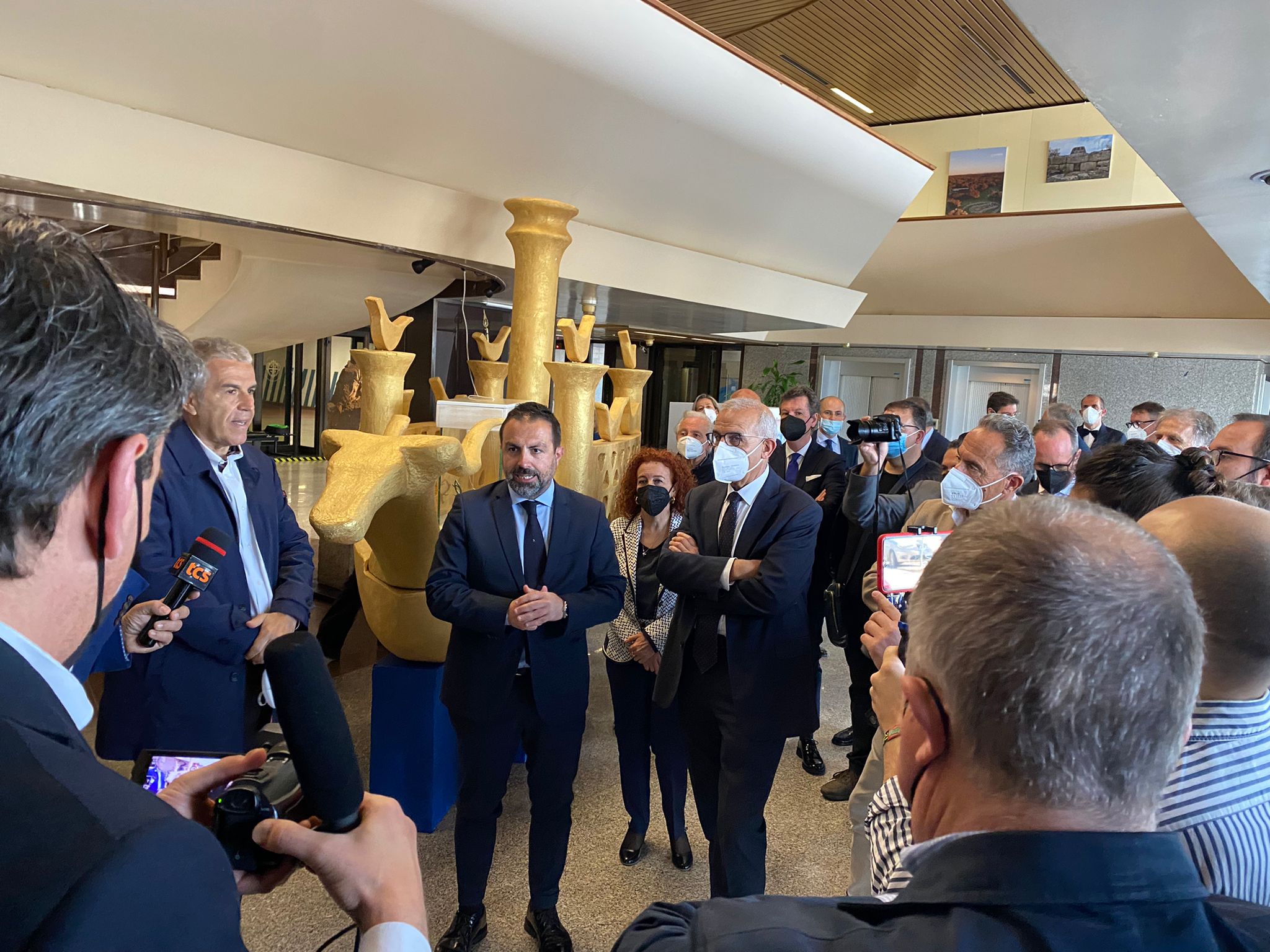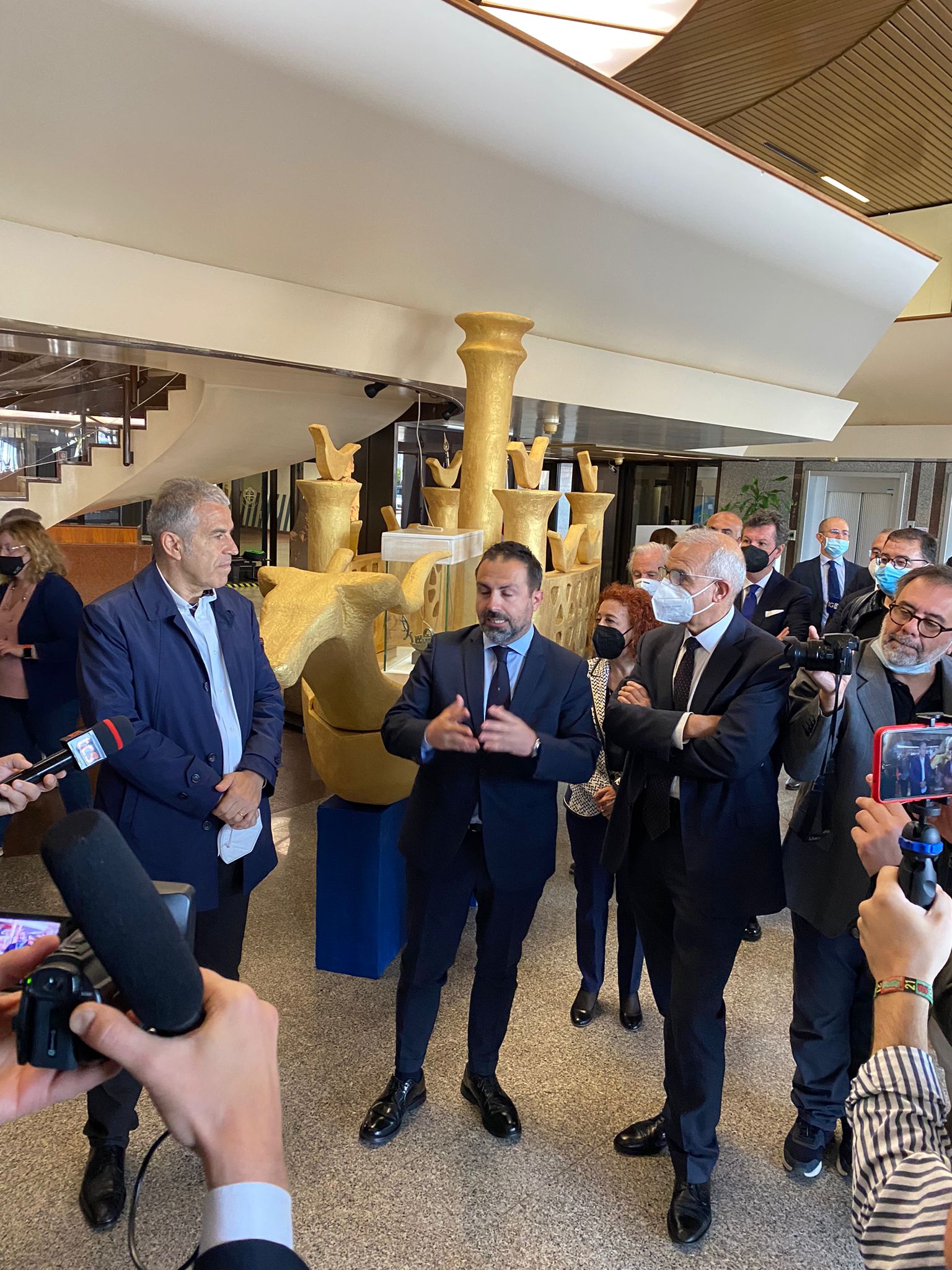“It is the most important initiative from a cultural point of view at this moment, and we are honored to host this exhibition in the Parliament of the Sardinians, certain that the path initiated (with the recognition by Unesco of the ancient Nuragic civilization as a World Heritage Site, ed.) will see us victorious. The Regional Council supports it wholeheartedly and unanimously with a motion from 2020 and the resources allocated by the Region.” With these words, the President of the Regional Council, Michele Pais, ideologically cut the ribbon of the exhibition “I open to Unesco,” which landed on May 3 in the Council, where it will remain until May 22, thus also embracing the initiative “Monumenti aperti.”
An extraordinary opportunity to spread the importance of the Nuragic monuments of Sardinia, especially for the new generations, thanks to 31 photographic panels and a faithfully reproduced Nuragic age vessel; the exhibition offers the chance to tangibly grasp the strategic significance of Sardinian history and culture for future development policies in Sardinia. With a new feature that once again speaks to the world of schools: on May 4 and 5, the protagonists were the students who, along with their teachers, visited the exhibition accompanied by an archaeologist. After the success of the junior master organized in Sardinia and then in Piedmont and the initiatives involving the Sardinian municipalities that have long, and with great enthusiasm, hosted the exhibition, offering opportunities for dialogue, study, and discussion on the Nuraghi to school groups from the towns, the Regional Council opened its doors for two days to groups of young people ‘hungry’ for Nuragic culture, who thanks to the Association “Sardegna verso l’unesco” can for the first time count on a series of initiatives aimed at enhancing the ancient Sardinian civilization both on the Island and beyond its borders, up to Paris with the request for recognition of the Nuragic heritage addressed to Unesco and sponsored by the Association.
A few days ago, accompanying the President of the Association Pierpaolo Vargiu in the discovery of the Nuraghi were not only President Pais and some members of the Regional Government, including the Councillor for Public Works, Aldo Salaris, the Councillor for Health, Mario Nieddu, and Regional Councillor Michele Cossa, the first signatory of the unanimously signed motion by the Council for the candidacy of the Nuraghi as a World Heritage Site, but also numerous mayors from all over Sardinia, representatives of the Sardinia Foundation and Banco di Sardegna, Banca di Cagliari, DICAAR (Department of Civil, Environmental and Architectural Engineering at the University of Cagliari), Crs4, Crenos, Anci, and the Regional School Office, who joined the scholars and archaeologists who participated in the presentation of the exhibition with the representatives of the Scientific Committee of the Association. It was instead a mayor-archaeologist, Franco Campus of Ittireddu, who illustrated the exhibition.
For Pierpaolo Vargiu, leading the Association, “This exciting journey has quickly brought us into the tentative list of Unesco, that is, the list of Italian sites proposed to become a World Heritage Site: this happened in November, and now we are working to achieve the result. But it would not have been possible,” Vargiu continued, “if we had not had the total support of the Sardinian institutions, including the mayors who signed the document for Unesco, the Regional School Office, Crenos, Crs4, the scientific committees of the universities of Cagliari and Sassari, just to name a few,” highlighting a strong identity value, a brand capable of driving all of Sardinia and changing the development of Sardinia. “This project is a project of cultural and economic revolution,” he continued, addressing the numerous participants at the inauguration of the exhibition. “One of our activities is to be subsidiary and complementary to the institutions, and once we acknowledged the importance of this project, we had no doubts. It is extraordinary to have managed to enter the tentative list; we stand by the Association,” said Carlo Mannoni, president of the Sardinia Foundation, officially announcing the full support of the foundation. Antonio Garrucciu (Banco di Sardegna) also spoke: “The enhancement of the archaeological heritage is fundamental. We believed in it, and today we are here too.” Aldo Pavan (Banca di Cagliari) made similar statements: “It is an honor to be here with our reality for an initiative of strong identity value.”
It was the archaeologist and mayor of Ittireddu, Franco Campus, who talked about the Nuraghi, the center of social life for the ancient Sardinians, introducing the theme in the atrium of the Regional Council and then illustrating each of the 31 photographic panels to the participants. Campus, with competence and attention to detail, succeeded in conveying the value and importance of the ancient Nuragic civilization, which, thanks to the projects carried out by the Association “La Sardegna verso l’unesco,” is today the cornerstone of a new development strategy for Sardinia.

